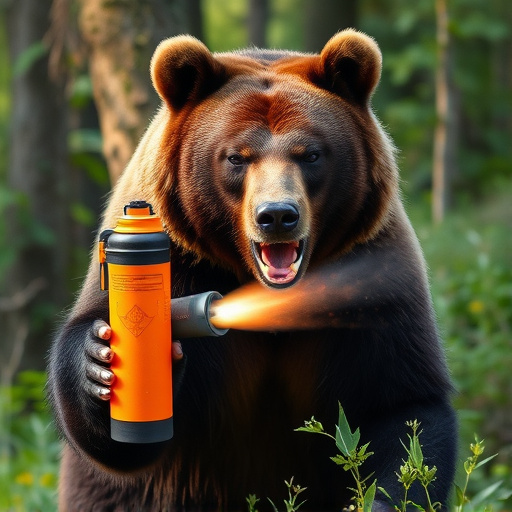Proper use of bear spray involves aiming at a bear's face within 20-30 feet, considering wind direction for enhanced effectiveness, and practicing application for optimal safety during encounters in the wilderness. Staying upwind or using terrain for protection can mitigate blowback from an unfavorable wind. Regular practice, targeting eyes to temporarily blind bears, and maintaining distance are key safety tips for maximizing deterrence while recognizing that bear spray is not a guarantee of safety.
“Navigating the wilderness requires preparation, especially when encountering one of nature’s most powerful symbols—bears. This article delves into the world of bear defense spray, a crucial tool for hikers and outdoor enthusiasts. We explore ‘Bear Spray Wind Direction Safety Tips’, uncovering the effectiveness of this defense mechanism and its optimal application. Understanding how wind direction impacts spray performance is key to staying safe in potential bear encounters. Read on to enhance your knowledge and ensure a secure experience in nature’s realm.”
- Understanding Bear Spray: Effectiveness and Application
- Wind Direction and Bear Spray Performance: A Critical Factor
- Safety Tips for Optimizing Bear Spray Defense During Encounters
Understanding Bear Spray: Effectiveness and Application
Bear spray, also known as bear defense spray, is a popular tool for outdoor enthusiasts and individuals living in bear country. When faced with an unexpected encounter, this pepper-based aerosol can provide a crucial layer of protection against aggressive bears. Understanding its effectiveness and proper application is essential for safety tips when navigating wild areas.
The spray creates a temporary but powerful barrier by releasing a stream of capsaicin, the active ingredient responsible for the burning sensation in chili peppers. When aimed correctly, it irritates the bear’s eyes, nose, and respiratory system, causing them to back away or flee. However, factors like wind direction play a significant role in its success; spraying into the wind might not deliver an effective dose. Users should aim for the bear’s face and ensure they are within the recommended range, typically around 20-30 feet (6-9 meters). Safety tips include practicing with the spray before venturing into potential bear country and always keeping it readily accessible while outdoors.
Wind Direction and Bear Spray Performance: A Critical Factor
Understanding wind direction is a crucial safety tip when carrying bear spray during a potential encounter in the wilderness. The effectiveness of bear spray heavily relies on proper application and timing, with wind playing a significant role. When spraying, aim for the bear’s face and eyes, as this area contains numerous sensory receptors that can detect and react to irritants. However, the wind’s direction can make this task more challenging.
If the wind is blowing in your favor, away from you, it increases the spray’s range and accuracy, ensuring the bear receives a direct hit. Conversely, if the wind is coming towards you, be prepared for reduced reach and potential blowback onto yourself. In such cases, consider moving to an upwind position or using terrain to shield yourself while still aiming for the bear’s face. Bear spray performance is directly linked to proper usage, so staying aware of the wind direction can significantly enhance your safety during an encounter with these majestic yet potent animals.
Safety Tips for Optimizing Bear Spray Defense During Encounters
When preparing for a potential bear encounter, understanding how to optimize your bear spray defense is crucial. One of the most important safety tips is to be aware of the wind direction. Always carry bear spray with you and ensure it’s accessible, but remember, wind plays a significant role in its effectiveness. Spraying into the face of an approaching bear may not be useful if the wind blows the spray away from the target. Therefore, when assessing the situation, consider the wind direction to maximize the spray’s impact.
Additionally, practice using your bear spray regularly so that you become comfortable with the timing and technique involved. Targeting the bear’s face and eyes is ideal, as it can cause temporary blindness and disorientation. Keep in mind that bear spray is a tool for deterrence, not a guarantee of safety. Always maintain distance and be prepared to retreat if needed.
When facing a potential wilderness bear encounter, proper usage of bear spray is crucial. Understanding its effectiveness and application, along with considering wind direction, can significantly enhance safety tips for optimal defense. By following these guidelines, outdoor enthusiasts can better prepare themselves and increase their chances of navigating such encounters successfully. Remember, knowledge and quick thinking are your best defenses in the wild.
